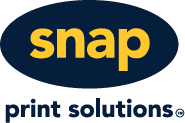Digital vs Offset Printing: What’s best for my job?
)
At some point in your professional life, you're likely to find yourself at an unusual crossroad where you are asked to make a split-second decision between two things you might not necessarily have heard of before: offset and digital printing. Depending on the job, the wrong decision could have a negative impact on the final product...or could it?
Read on to find out which type of printing is best suited for your next printing job.
What is Digital Printing?
Digital printing started to gain traction in the 1990s, though back then it was mainly referred to as 'copying'. After all, its main purpose was to replicate the contents of the original document placed in the machine.
Nowadays, digital printing is capable of much more than that. In fact, on many levels, it rivals traditional offset printing technologies not only by streamlining many production processes, but also in terms of printing quality.
How digital printing works
Instead of using liquid ink like offset printers do, digital presses use different types of toner. What's more, a digital printing press is fed the original file digitally so there is no need to pre-produce printing plates. This dramatically reduces your set-up costs and overall production time. However, this also means your PPU remains the same for every print. This makes digital printing a more economical choice for smaller jobs of approximately 500 units or less.
Advantages of digital printing
Advantages of digital printing include:
Speed: Digital printing is generally faster than offset printing, as it does not require the creation of printing plates. This makes it a good choice for projects with tight deadlines.
Versatility: Digital printing is very versatile due to the fact that it offers Variable Data Printing (VDP), which enables you to customise details on your prints, such as names, addresses and even images. Digital printing can also handle a wide range of paper sizes and finishes.
Personalisation: Digital printing allows for personalisation of prints, as it is easy to customise each print with different text or images.
Lower minimum quantities: Digital printing has a lower minimum quantity requirement than offset printing, making it a good choice for shorter print runs.
Cost-effective for shorter print runs: Digital printing is generally more cost-effective for shorter print runs, as the cost per print does not decrease as significantly as it does with offset printing.
Environmental impact: Digital printing has a lower environmental impact than offset printing, as it uses less water and produces less waste.
Applications of digital printing
Here are some examples of materials that are commonly printed using digital printing:
Packaging, labels and boxes
Photo and canvas prints

What is Offset Printing?
Offset printing is a printing method that involves transferring ink from a printing plate to a rubber blanket and then onto the printing surface. It is a popular choice for printing high volumes of materials, such as books, magazines, and brochures.
How offset printing works
Similar to the early days of book printing, commercial offset printing uses metal plates, usually made from aluminium, to print the design onto your paper stock. This means that before the printing process can get started, the printer has to burn your image onto custom plates.
In the next step, the plates transfer the image onto a rubber film that then rolls it onto the paper. This is where offset printing gets its name, as the ink is not printed on the stock directly but via the rubber film.
Naturally, this kind of set-up process is a little more time consuming than setting up a digital print job, which is why offset printing is not the best choice for extremely time-sensitive jobs. It also doesn't leave any room for error as once the plates have been produced, there's no turning back. If you do discover a typo, the only way to correct it is a complete do-over.
Advantages of offset printing
The main advantages of offset printing include:
High quality: Offset printing typically produces high quality prints with a wide colour gamut and good accuracy. It is especially well-suited for printing materials with small text or fine details, as it can produce crisp, clear prints.
Economical for large print runs: Offset printing is generally more cost-effective for larger print runs, as the cost per print decreases as the volume increases.
Versatility: Offset printing can handle a wide range of paper sizes and types, including thick cardstock and coated papers. It is also capable of printing on a variety of materials, such as plastics and metals.
Consistency: Offset printing is known for producing consistent results, as it uses printing plates that are created from a high-resolution digital file. This ensures that each print is exactly the same as the last.
Durability: Offset printed materials are generally more durable than those printed digitally, as the ink is applied more thickly and the prints are less prone to fading or smudging.
Applications of offset printing
Offset printing is a popular printing method that is well-suited for a wide range of applications, including:
Books
Magazines

Comparison of Digital and Offset Printing
Digital printing and offset printing are both effective printing methods, but they differ in four key areas:
1. Quality and resolution
Digital printing: Digital printing can produce high quality prints with good resolution, but the quality may vary depending on the specific printer and print settings.
Offset printing: Offset printing typically produces higher quality prints with a wider colour gamut and good resolution, especially for materials with small text or fine details.
2. Cost and turnaround time
Digital printing: Digital printing is generally more cost-effective for shorter print runs and has a faster turnaround time, as it does not require the creation of printing plates.
Offset printing: Offset printing is generally more cost-effective for larger print runs, but has a longer turnaround time due to the need to create printing plates.
3. Environmental impact
Digital printing: Digital printing has a lower environmental impact than offset printing, as it uses less water and produces less waste.
Offset printing: Offset printing has a higher environmental impact than digital printing, as it uses more water and produces more waste.
4. Customisation and flexibility
Digital printing: Digital printing is highly flexible and allows for each print to be easily customised.
Offset printing: Offset printing is less flexible and does not allow for as much customisation.
Factors to consider when choosing between digital and offset printing:
1. The volume of the print run
As mentioned, digital printing is typically more cost-effective for shorter print runs, while offset printing is more cost-effective for longer runs. If you need a large quantity of prints, offset printing may be the more economical choice.
2. The type of project or materials being printed
The type of project you are printing, as well as the materials you will be using, can also affect your choice of printing method. For example, if you are printing materials with a lot of small text or fine details, offset printing may produce better results, as it can produce crisper, more accurate prints. On the other hand, if you are printing materials with large areas of solid colour, digital printing may be a better choice, as it can produce vibrant, consistent colours.
3. The desired turnaround time
Digital printing is generally faster than offset printing, as it does not require the creation of printing plates and allows for on-demand printing. If you need your materials quickly, digital printing may be the better choice. However, if you have more time and are willing to wait for the printing plates to be created, offset printing may still be a viable option.
Deciding whether digital or offset printing is right for your job
When deciding between digital and offset printing, it is important to consider the specific needs and requirements of your project, including the volume of the print run, the type of materials being printed, the desired turnaround time, and your budget. By carefully weighing these factors, you can choose the printing method that best meets your needs and produces the best results.
Snap's national network of printing experts is here to offer you advice during each step of your project. Contact your local Snap Centre Today.


